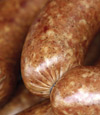
Sausages have long been a consumer favorite, but the production of them isn’t always an easy thing. One mis-step in the process – meat that’s not cold enough, a stuffing horn that’s too small for the casing – and the finished product won’t have the same visual appeal of a perfectly made product.
Joe Cordray, extension meat specialist at Iowa State University, notes that the first step in the grinding and stuffing process is to make sure the meat is the correct temperature.
“The meat has to be cold in order for it to grind and achieve good particle definition,” he explains. “Good particle definition is defined as being able to see distinct particles of fat and lean.” Meat that’s too warm may smear during the process, resulting in a less attractive sausage.
Meat from different species will react different when ground, so the processor will have to keep those differences in mind as well. Beef, compared to pork and poultry, would achieve the best particle definition, Cordray says, because the fat has a higher percentage of fatty acids in it. Additionally, a leaner blend will grind cleaner than a fatter blend.
Poultry sausage, which is very lean, has been growing in popularity. Cordray notes that temperature is critical when producing a good chicken sausage.
“If you’re grinding poultry sausage, you could grind it as low as 27 degrees,” he says. “You would certainly like to be in the low 30s. It is possible with good temperature control, and good, sharp knives and grinder plates, to produce a poultry sausage with excellent particle definition.”
Another popular item has been sausages with inclusions, such as chunks of cheese or fruits. Ideally in a sausage, the best particle definition is achieved when the final grind is done as close to the stuffing as possible, so a processor would coarse-grind the meat, add the non-meat ingredients and run it through a final grind.
“If you’re going to put an inclusion in there and you want it to be visible,” Cordrays explains, “it obviously has to be added after the final grind. What you want to do in a case like that is use really good temperature control and really good equipment. Do your coarse grind, mix in all of your non-meat ingredients except for your inclusions, go through your final grind and then blend in [the inclusions]. Mix it just long enough to blend them in and get them distributed throughout the product.”
Tech tips
Another way to make sure the sausages are expertly produced is to ensure that the stuffer is not putting the meat under too much pressure to force it out of the horn, as that will cause the meat to smear.
“There has been considerable improvements in stuffers where the meat moves readily through the stuffing operations rather than being pressured a lot,” Cordray says. “A lot also depends on the type of horn you use.”
The horn should be as close in diameter to the inside of the casing as possible. It should also be the minimum length needed to accommodate the size of the casing. If the horn is too small, meat will spread out to fill the casing and work around the outside of the horn, and the result is a noticeable swirl pattern in the finished product, where the meat fibers have been realigned in a circular pattern.
When it comes to grinders, the grinding plates play an important role in obtaining good particle definition. They should be sharp, as should the grinding knives. Cordray also likes the plates that feature a bone-collecting apparatus, which works the bone chips that may be present into the middle, where they are expelled out of the product.
The assembly of the plate and corresponding knife is also important. If those two items are put together too loosely, it will not cut well. However, if it’s put together too tightly, the tooling will burn out from the metal-on-metal contact.
“What lubricates that knife and that plate is the meat passing through it,” Cordray notes, “which is why a lot of people, when they assemble it first thing in the morning, will put a little mineral oil on the blade to make sure there’s a little bit of lubrication on the plate while they’re waiting for the auger to bring that first bit of meat up to it.”
Cordray also points out that a grinder plate and a knife will eventually seat to each other, essentially becoming a match set. A processor that uses one knife and keeps switching out grinder plates is destroying that seat and will not get as good results as one that uses the same knife with the same grinder plate.
Sanitation for grinders and stuffers is particularly important, because those machines have many niches and crevices where meat can get stuck. Cordray says that a company needs to pay extra attention to the cleaning and sanitizing of that equipment. He also recommends that maintenance people and machine operators be well-versed on the operating procedures for that particular stuffer and grinder.
“Different companies have different recommendations on it, and most of the companies do a considerable research to figure out the most effective way to use their equipment,” he says. “If you are trying to use it differently than how that equipment is designed, most of the time it will have a deleterious effect on your results.”


